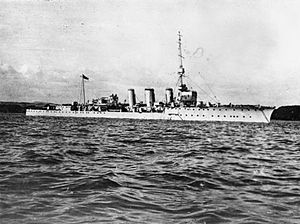
Back HMS Cordelia (1914) Greek اچاماس کوردلیا (۱۹۱۴) Persian HMS Cordelia (1914) Finnish HMS Cordelia (1914) French HMS Cordelia (1914) Ukrainian HMS Cordelia (1914) Vietnamese
 Cordelia during World War I
| |
| History | |
|---|---|
| Name | Cordelia |
| Namesake | Cordelia of Britain |
| Builder | HM Dockyard, Pembroke |
| Laid down | 21 July 1913 |
| Launched | 23 February 1914 |
| Completed | January 1915 |
| Commissioned | January 1915 |
| Decommissioned | 1919 |
| Recommissioned | January 1920 |
| Decommissioned | December 1922 |
| Identification | Pennant number: 78 (1914); 50 (Jan 18);[1] 69 (Apr 18); P.09 (Nov 19); 65 (Jan 22)[2] |
| Fate | Sold for scrap, 31 July 1923 |
| General characteristics (as built) | |
| Class and type | C-class light cruiser |
| Displacement | 4,175 long tons (4,242 t) (normal) |
| Length | 446 ft (135.9 m) (o/a) |
| Beam | 41 ft 6 in (12.6 m) |
| Draught | 16 ft (4.9 m) (mean) |
| Installed power |
|
| Propulsion | 2 × shafts; 2 × steam turbines |
| Speed | 28.5 knots (52.8 km/h; 32.8 mph) |
| Range | 3,680 nmi (6,820 km; 4,230 mi) at 18 knots (33 km/h; 21 mph) |
| Complement | 301 |
| Armament |
|
| Armour |
|
HMS Cordelia was a C-class light cruiser built for the Royal Navy during World War I. She was one of six ships of the Caroline sub-class and was completed at the beginning of 1915. The ship was assigned to the 1st and 4th Light Cruiser Squadrons (LCS) of the Grand Fleet for the entire war and played a minor role in the Battle of Jutland in mid-1916. Cordelia spent most of her time on uneventful patrols of the North Sea. She served as a training ship for most of 1919 before she was recommissioned for service with the Atlantic Fleet in 1920. The ship was placed in reserve at the end of 1922 and was sold for scrap in mid-1923.